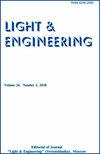山地日光气候的模拟是评估房屋日照和照明的先决条件
IF 0.3
4区 工程技术
Q4 ENGINEERING, ELECTRICAL & ELECTRONIC
引用次数: 0
摘要
本文分析了目前规范房屋和城市日照要求的文件,以及复杂山地地形条件下根据地理纬度区域边界的领土的太阳光照制度,以确定其研究程度。在这方面,确定在上述地图中,在气候和太阳光照因素方面,山区地区和国家的分区突出显示为未开发或研究不足的地区。强调了具有特殊日照-光照气候条件的山地地区的日光-光照气候指标。定义了求解该问题的算法,对某典型山地复杂地形的太阳-光气候进行了评价和分析,揭示了复杂地形对光气候特征的影响。考虑了一种评估太阳辐射的定性和定量指标的方法,大气的状态,日照的概率和持续时间,直接、散射、反射和总辐射到达水平和不同方向的倾斜、垂直表面的时间变化的大小和性质,以及后者在复杂山地地形上潜在建筑的比例,造成建筑物的太阳光环境。可以确定的是,在研究不同方向的倾斜表面上来自太阳穹顶的辐射量的基础上获得的信息材料使我们能够更准确地考虑其对室内光气候状况的影响,并在评估室内小气候因素和封闭结构的热物理特性时确定进一步研究的方向。已经开发了一种通过确定其类型来模拟特征地貌的方法,并建立了直接,散射,反射和总太阳辐射流向不同方向斜坡的规律,这决定了建筑场所的光气候,可以用于评估其日照-光气候制度,以及纠正照明水平的计算方法。本文章由计算机程序翻译,如有差异,请以英文原文为准。
Modelling of the Solar-Light Climate of Mountain Terrain is a Prerequisite for Assessing the Insolation and Illumination of Premises
The article analyses the current documents regulating the requirements of the insolation of premises and urban areas, as well as the solar-light regime of territories depending on the boundaries of zones along geographical latitudes for the conditions of complex mountainous terrain in order to identify their degree of study. In this regard, it is determined that in the above maps, the zoning of territories, countries on mountainous terrain are highlighted as an unexplored or poorly studied zone in terms of climatic and solar-light factors. The indicators of the solar-light climate of mountain territories characterized by a special insolation-light-climatic condition are highlighted. The algorithm for solving the problem is defined, which includes the assessment and analysis of the solar-light climate of a characteristic mountainous complex relief, revealing the influence of complex relief on light-climatic characteristics. A methodology for assessing qualitative and quantitative indicators of solar radiation, the state of the atmosphere, the probability and duration of sunshine, the magnitude and nature of changes in time of direct, scattered, reflected, and total radiation coming to horizontal and variously oriented inclined, vertical surfaces, the ratio of the latter on complex mountainous terrain potentially construction, causing the solar-light environment of buildings are considered. It is established that the information material obtained on the basis of research on the amount of radiation coming from the solar dome on inclined surfaces of various orientations allows us to more accurately take into account its effect on the indoor light-climatic regime and, along with it, determines the direction of further research when assessing also the factors of indoor microclimate and thermo-physical characteristics of enclosing structures. A method for modelling characteristic landforms with determining their typology has been developed and a regularity has been established for the flow of direct, scattered, reflected and total solar radiation to differently oriented slopes, which determine the light climate of building premises, which can serve to assess its insolation-light-climatic regime, as well as to correct the calculation method of illuminance levels.
求助全文
通过发布文献求助,成功后即可免费获取论文全文。
去求助
来源期刊

Light & Engineering
ENGINEERING, ELECTRICAL & ELECTRONIC-OPTICS
CiteScore
1.00
自引率
50.00%
发文量
0
审稿时长
1 months
期刊介绍:
Our magazine
develops comprehensive communication within the lighting community, providing opportunities for discussion and free expression of opinions of specialists of different profiles;
contributes to the convergence of science and engineering practice, the search for opportunities for the application of research results in lighting and technological applications of light;
keeps the scientific community up to date with the latest advances in the theory of the light field, providing readers with operational professional information;
initiates international cooperation, promotes and distributes the results of Russian authors in the international professional community;
provides equal opportunities for authors from different regions of Russia and other countries.
The journal publishes articles in the following areas:
visual and non-visual effects of radiation on humans;
light field theory;
photometry and colorimetry;
sources of light;
ballasts;
light devices, their design and production technology;
lighting and irradiation installation;
light signaling;
methods of mathematical modeling of light devices and installations;
problems of energy saving in lighting, installation and operation of lighting installations;
modern production technologies of lighting products for lighting control systems;
innovative design solutions;
innovations in lighting and lighting design;
the study of the effect on plants and animals, problems of using light in medicine;
problems of disinfection of premises, water and smell elimination with the help of technology of UV radiation using;
problems of light in the ocean and space.
 求助内容:
求助内容: 应助结果提醒方式:
应助结果提醒方式:


